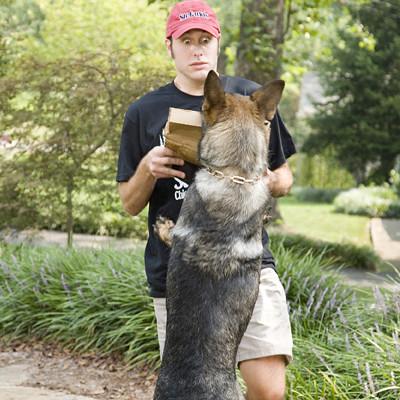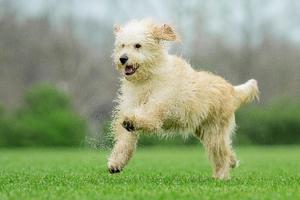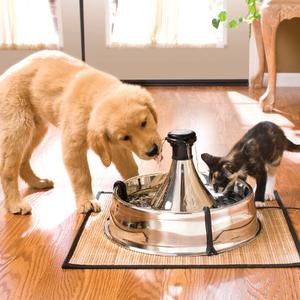What Counts as Aggressive Behavior?
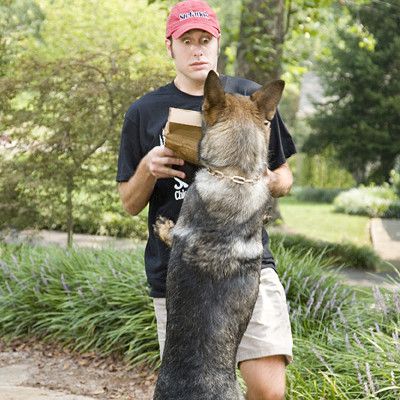 Aggressive behavior in dogs can be dangerous and expensive. According to the Center for Disease Control, an estimated 4.5 million people suffer dog bites each year and approximately 800,000 of these are serious enough to warrant a hospital visit. The Insurance Information Institute reports the average hospital cost and homeowner’s insurance claim for a dog bite injury was approximately $18,000 and $30,000, respectively, in 2012. Not surprisingly, canine aggression is the most common behavior problem treated by veterinary behaviorists.
Aggressive behavior in dogs can be dangerous and expensive. According to the Center for Disease Control, an estimated 4.5 million people suffer dog bites each year and approximately 800,000 of these are serious enough to warrant a hospital visit. The Insurance Information Institute reports the average hospital cost and homeowner’s insurance claim for a dog bite injury was approximately $18,000 and $30,000, respectively, in 2012. Not surprisingly, canine aggression is the most common behavior problem treated by veterinary behaviorists.
Most people become very upset when professionals use the term “aggression” to describe their pet’s behavior. Behavioral scientists, however, do not use the term synonymously with “bad,” “mean,” or “dangerous,” but instead simply use the word to label any threatening and potentially harmful action to another animal.
Just like people, animals display a range of body postures and vocalizations to say “BACK OFF.” These are almost always normal behaviors that are nonetheless unacceptable due to the dangerous consequences. Harsh barking, growling, snarling, snapping (biting behavior without making contact with target), and biting are the most obvious forms of aggression. Recognizing more subtle signs and diffusing tensions are critical in treating aggression.
Why Are Dogs Aggressive towards Strangers?
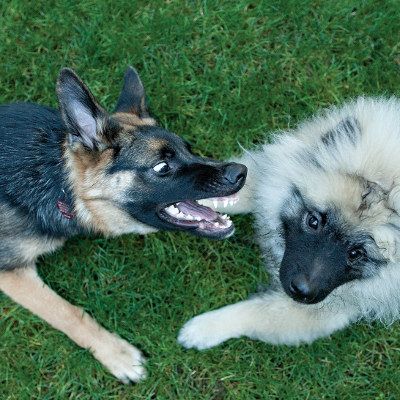 Aggression to non-family members can occur outside the home or yard, but most dog bites occur near the dog’s home. Dogs are social creatures and naturally form groups and bonds with both human and family members. Scientists recognize big differences in dog and wolf groups and do not use the word “pack” when describing dog groupings – more to come on the posts discussing canine aggression to family members. To some extent, all dogs are also territorial by nature, and will defend an area that contains important resources from outsiders.
Aggression to non-family members can occur outside the home or yard, but most dog bites occur near the dog’s home. Dogs are social creatures and naturally form groups and bonds with both human and family members. Scientists recognize big differences in dog and wolf groups and do not use the word “pack” when describing dog groupings – more to come on the posts discussing canine aggression to family members. To some extent, all dogs are also territorial by nature, and will defend an area that contains important resources from outsiders.
Textbook definitions of territorial aggression usually describe very assertive and offensive body postures: forward stiff body, tail flagged, ears up, hard stare, and lots of harsh barking. Theoretically the aggression should not occur once the dog is off the territory (which could be owner’s property, but also commonly walked areas and vehicles).
While it is possible that a dog that is quite aggressive in the house, yard, or car will show very friendly signals (loose/relaxed body and tail, and “soft” eye contact) outside of these areas, in practice, I usually note wary or more fearful body language towards strangers off the territory in these same dogs. This leads many behaviorists to believe that aggression to visitors near the home is also a defensive behavior.
Most dogs that are feeling uncomfortable about interacting with an unfamiliar person begin to show low-level stress behaviors such as lip licking, yawning, averting eyes, and possibly whining. If the animal feels trapped, for example when physically blocked or held in place by a leash as the target approaches, the dog often feels compelled to increase the aggressiveness of his signals, resulting in growling, snarling and even lunging, snapping, and biting in an attempt to drive the person away.
Because the early warning signals are often ignored and only overt behaviors seem to be effective in stopping the stranger from approaching or petting, the aggression is reinforced and a dog that is feeling defensive often appears very assertive over time.
How Should I Deal with Dog Aggression?
 Safety is paramount when treating any form of aggression. In general, dogs should not be allowed to rush the door or continuously chase passersby from the yard, particularly if there is a bite history. Placing a solid barrier between the dog and target is the safest management plan, and I always recommend training the dog to go to a certain location, like a crate or bedroom on command when the doorbell rings or there is a knock at the door. Likewise, teaching the dog to go to a certain location in the backyard is a great way to disrupt the behavior without worsening the aggression.
Safety is paramount when treating any form of aggression. In general, dogs should not be allowed to rush the door or continuously chase passersby from the yard, particularly if there is a bite history. Placing a solid barrier between the dog and target is the safest management plan, and I always recommend training the dog to go to a certain location, like a crate or bedroom on command when the doorbell rings or there is a knock at the door. Likewise, teaching the dog to go to a certain location in the backyard is a great way to disrupt the behavior without worsening the aggression.
Although these are not difficult behaviors to place on cue, consulting with a behavioral professional to help improve results is always a great idea. Basket-type muzzles and head collars like the Gentle Leader are wonderful tools for aggressive dogs. As the dog starts to become agitated, a calming redirection command like “watch me” is the main behavior modification tactic but a head collar provides the best “power steering” and most sensitive control over the mouth of the dog if inevitably a target gets closer than the dog would like.
Every effort should be made help the dog associate the muzzle and head collar with pleasant experiences like food, toys, or play. If the dog resents the device, this will likely make her feel more agitated and aggressive while around the target.
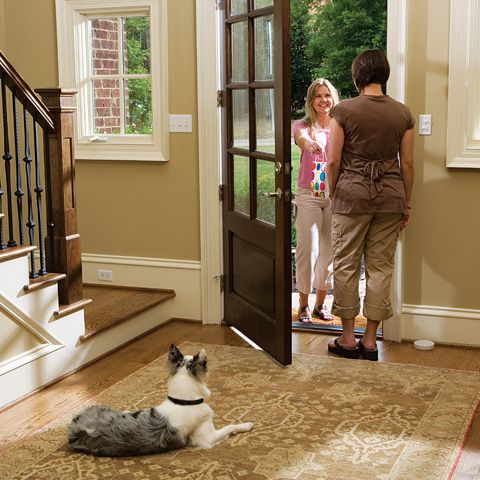 What Other Options Do I Have?
What Other Options Do I Have?
I am often asked why I do not use aversive corrections when treating aggression. The dog is acting inappropriately; why not make him understand bad things will happen when he continues to act aggressively? It’s all about Pavlov’s dogs.
Ivan Pavlov discovered that animals (including humans) can form emotional connections with any target. A bell that is associated with food delivery a few times can make a dog salivate even without the food being present. A person on the street can make a dog tense and aggressive if that dog has been repeatedly subjected to a painful or fear-producing stimulus around people on the street previously. Corrections can be effective in suppressing certain behaviors, but that philosophy does not address the core emotional distress.
Behaviorists understand that focusing on this fear or discomfort and decreasing the motivation to become aggressive by reinforcing calm behaviors produces the longest lasting results and happiest dogs and families.

